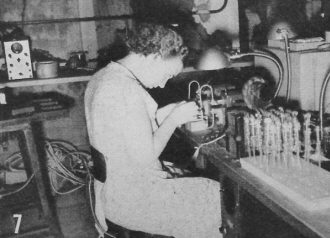|



Figs. 1, 2, 3 - Trimming screens of 2", 9", and 12" tubes.
They must be evenly trimmed to insure a perfect picture. Tubes must stand tremendous
pressure



Figs. 9, 10, 11- Bombarding tubes. This heats elements
of tube to white-hot temperature. Released gases are drawn off by the mercury pump.


Figs. 13, 14 - Oscillographs on the production line. Here raw
parts are wired in and components are properly mounted.
|

Fig. 4 - Annealing tubes. Stress in glass must be minimized
or moved to center out of danger zone. This process shortens and flares blank to
prevent any chipping.

Fig. 5 - Assembling stem mounts. Wires are placed between jaws
with glass collar. Jaws revolve between flames which heat collar and "cement" it
to wires forming stem mount.

Fig. 6 - The exhaust port of 2" tube is formed by a glass blower.
An ancient art for the most modern discovery.


Figs. 7, 8 - Stem mounts being assembled prior to insertion in
collars. Essentials are spot-welded to insure complete rigidity. Frequent inspections
assure early discovery of imperfections.

Fig. 12 - The finished tube is examined for stress and strain
by means of a polariscope. Variegated hues reflected indicate strain is present.

Fig. 15 - Testing the action of the completed oscillograph. Long
tests are necessary to insure against breakdown in use. Accuracy is essential and
tubes are so designed to give this result. Time studies are made to determine deterioration.

Fig. 16 - Allen B. DuMont examines a 12 in. Cathode Ray tube.
This is one of the largest manufactured. They must be gingerly handled because of
the constant danger of an implosion (the opposite of "explosion"). With careful
construction and the shifting of the stresses to the center of the tube (See picture
No.4), this occurrence is minimized. The source of the implosion is the external
air pressure of 15 lbs. to the square inch to which the tube is constantly subjected.
Without the outside air pressure, C.R. tubes could be built to any size and the
picture projected could be as large as the ordinary movie.
|
























